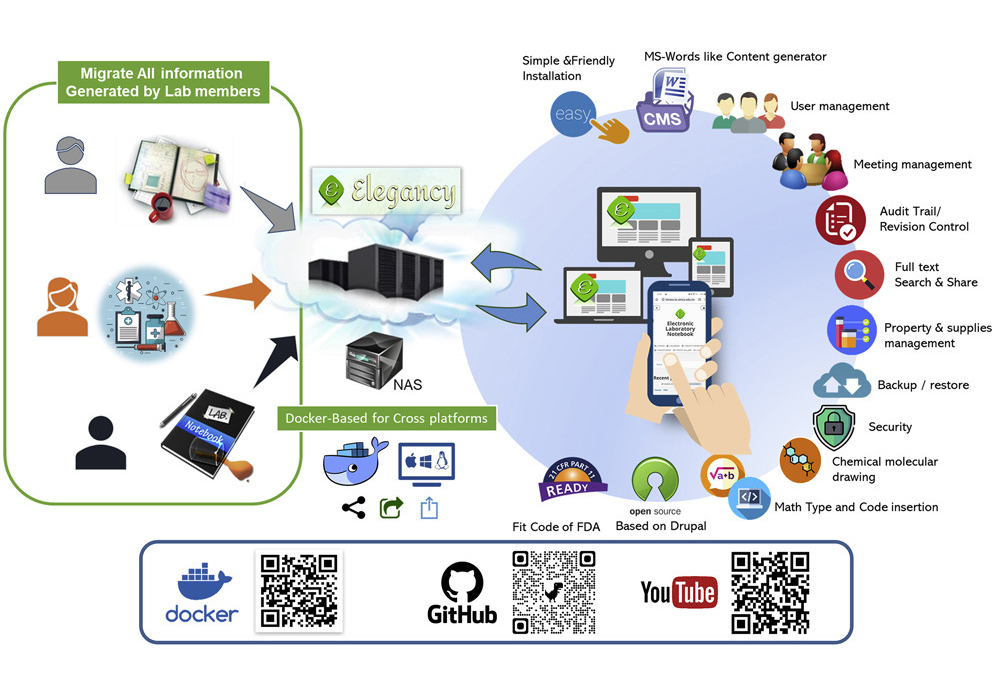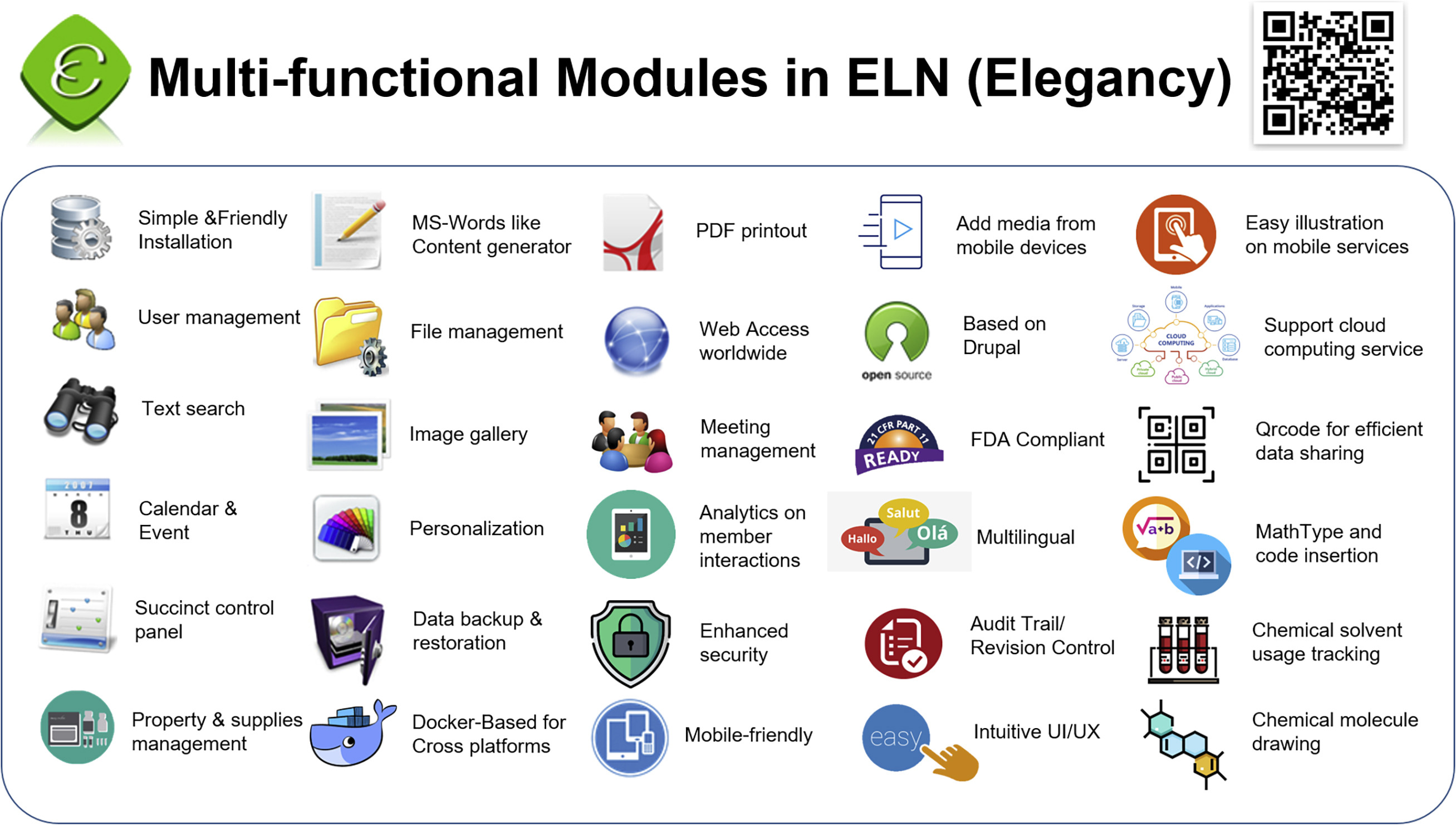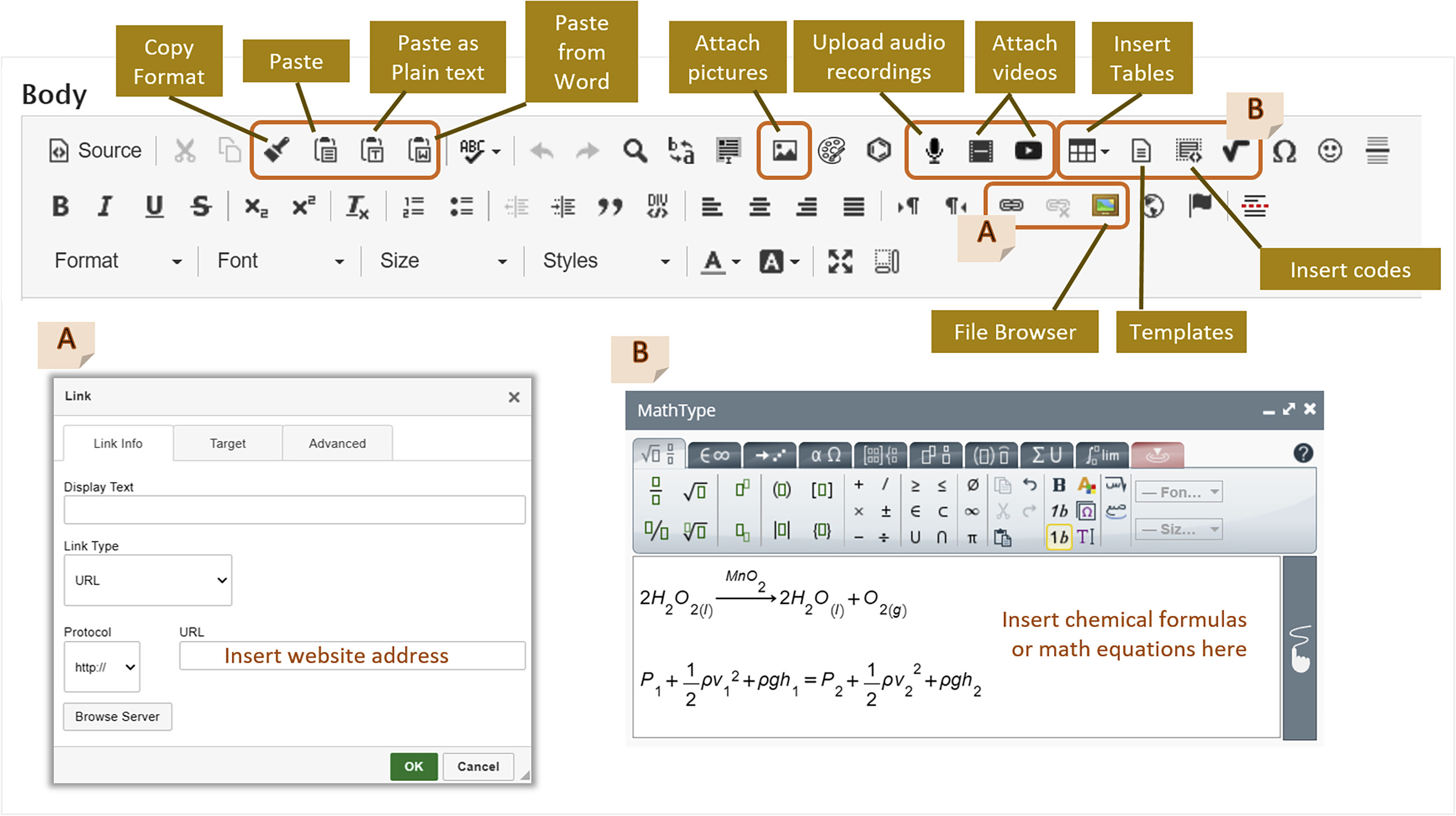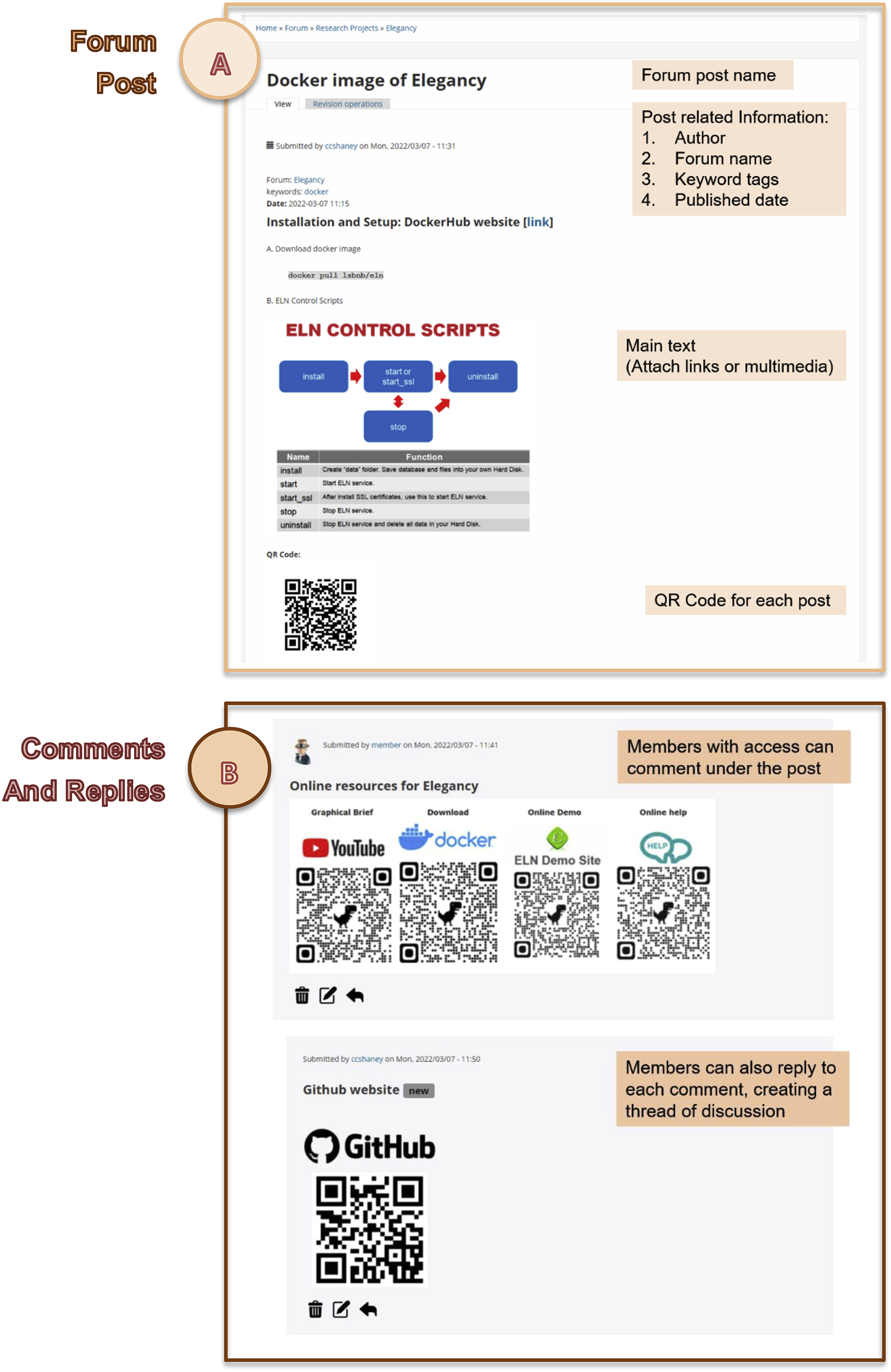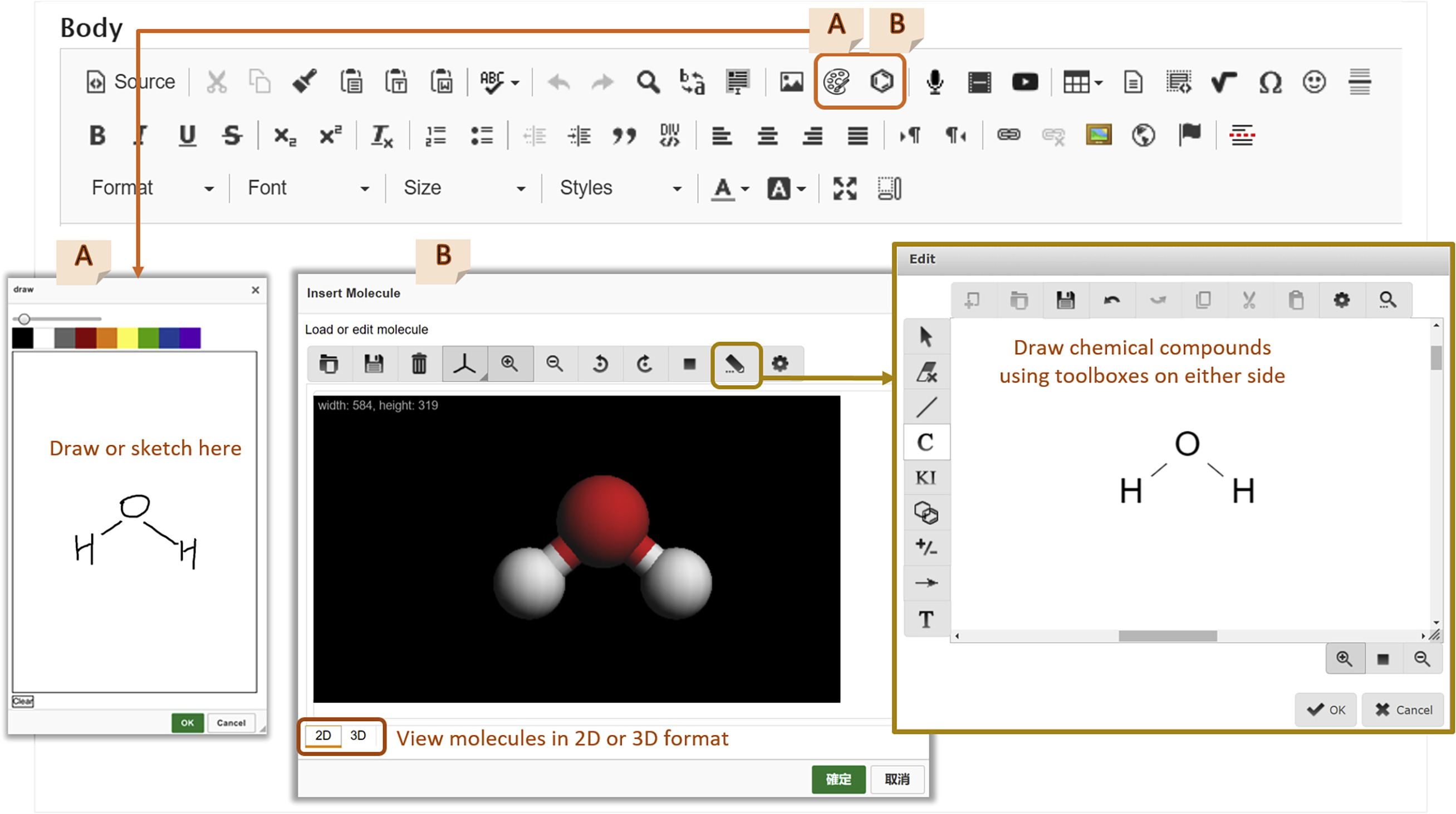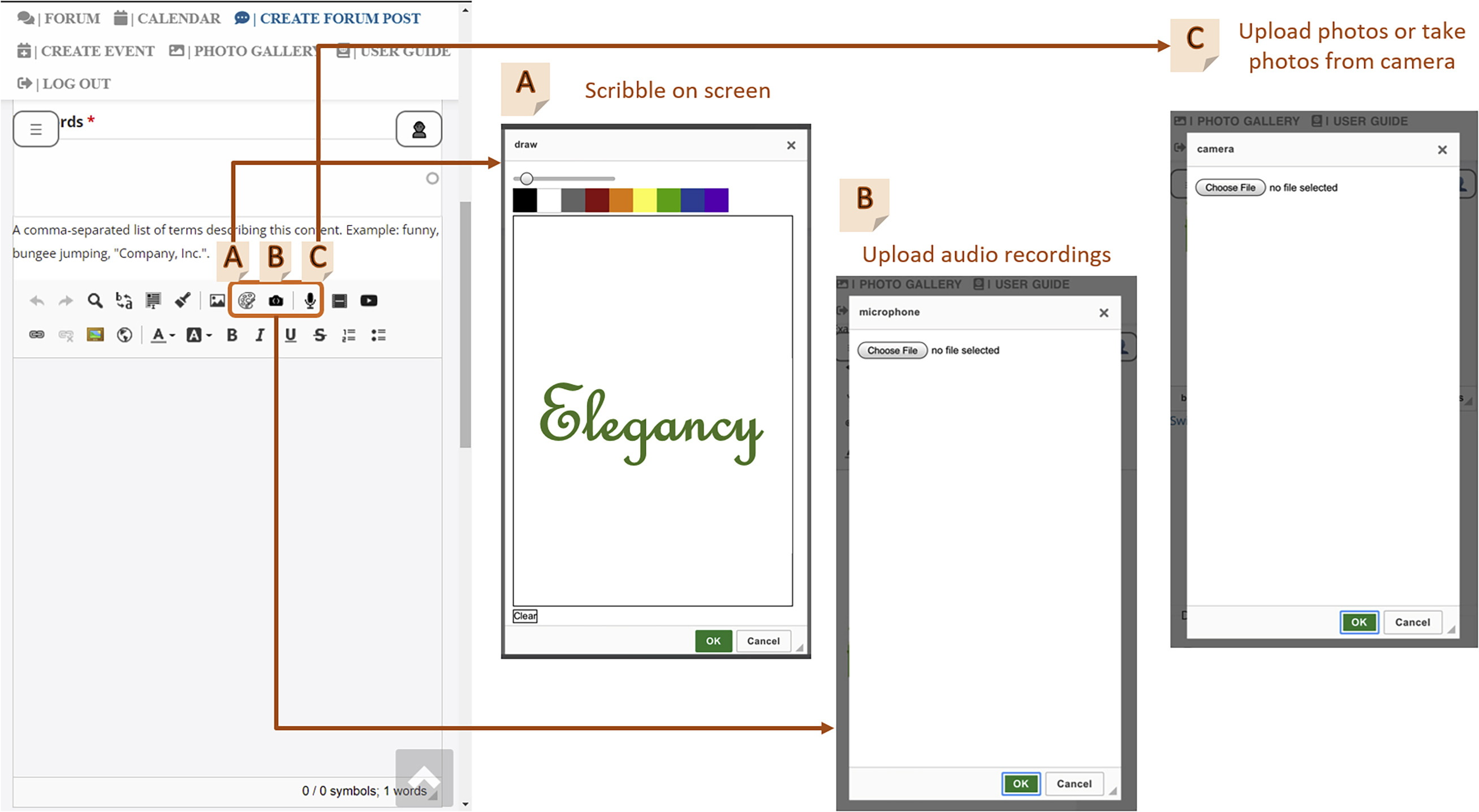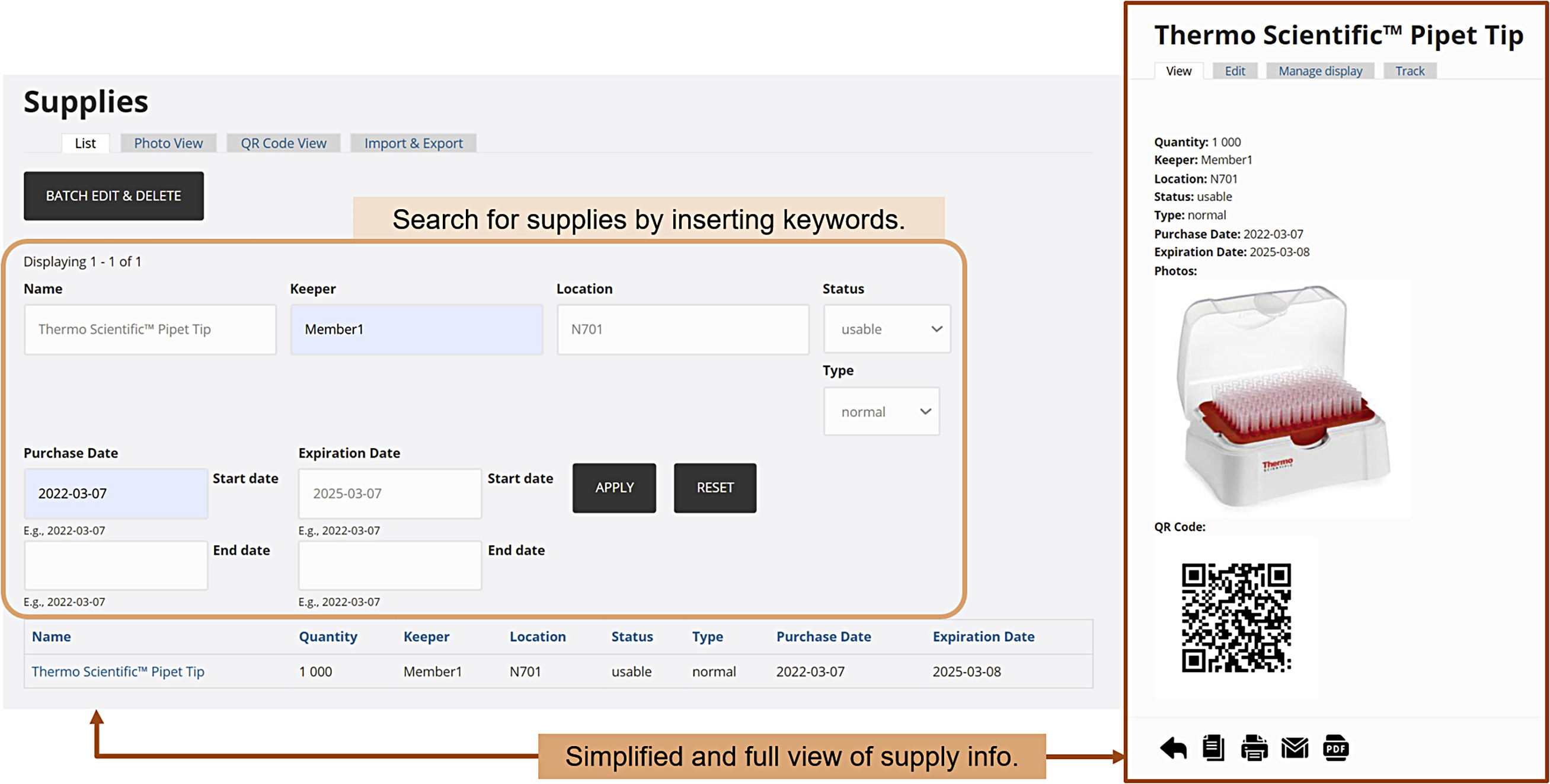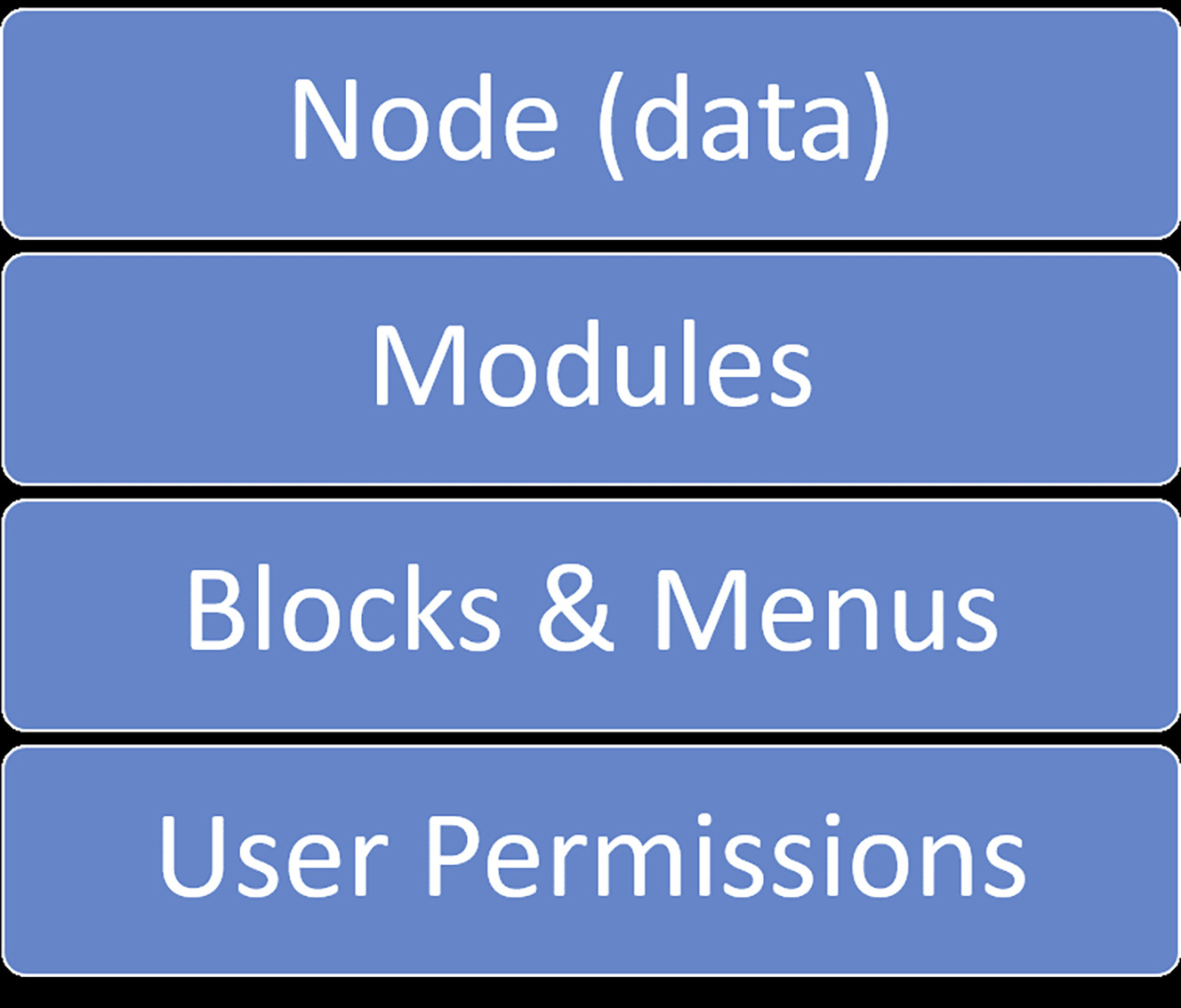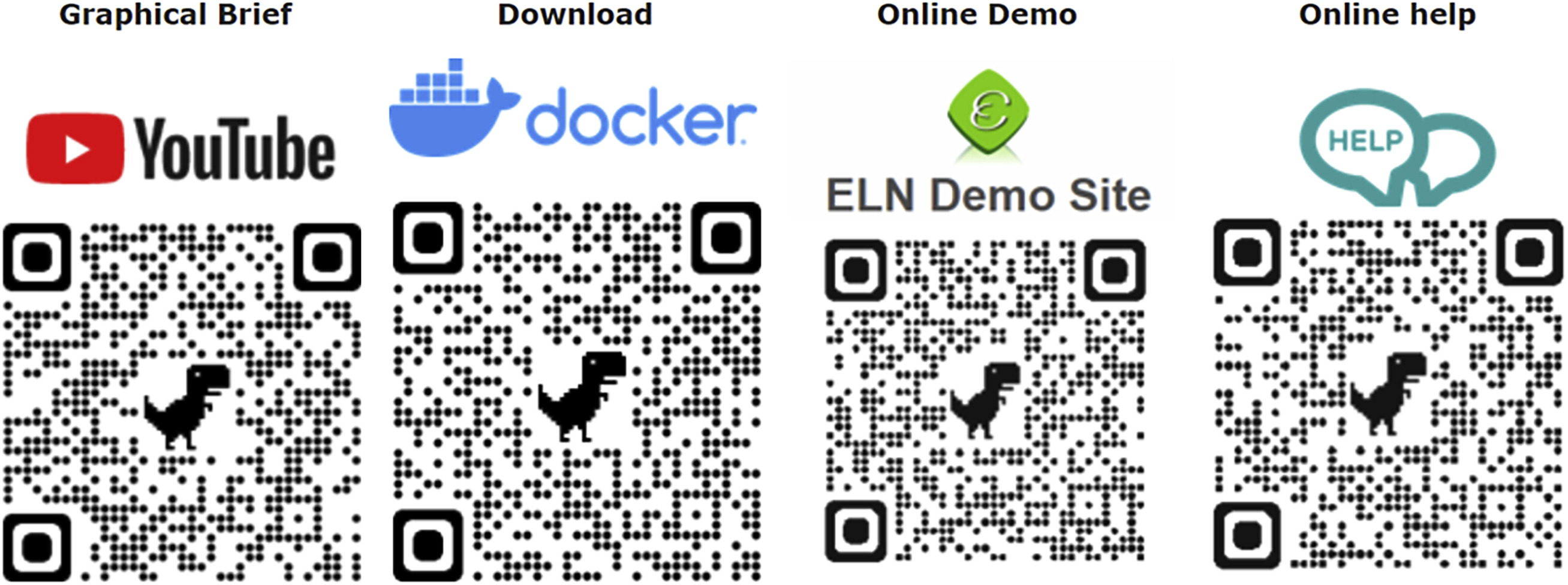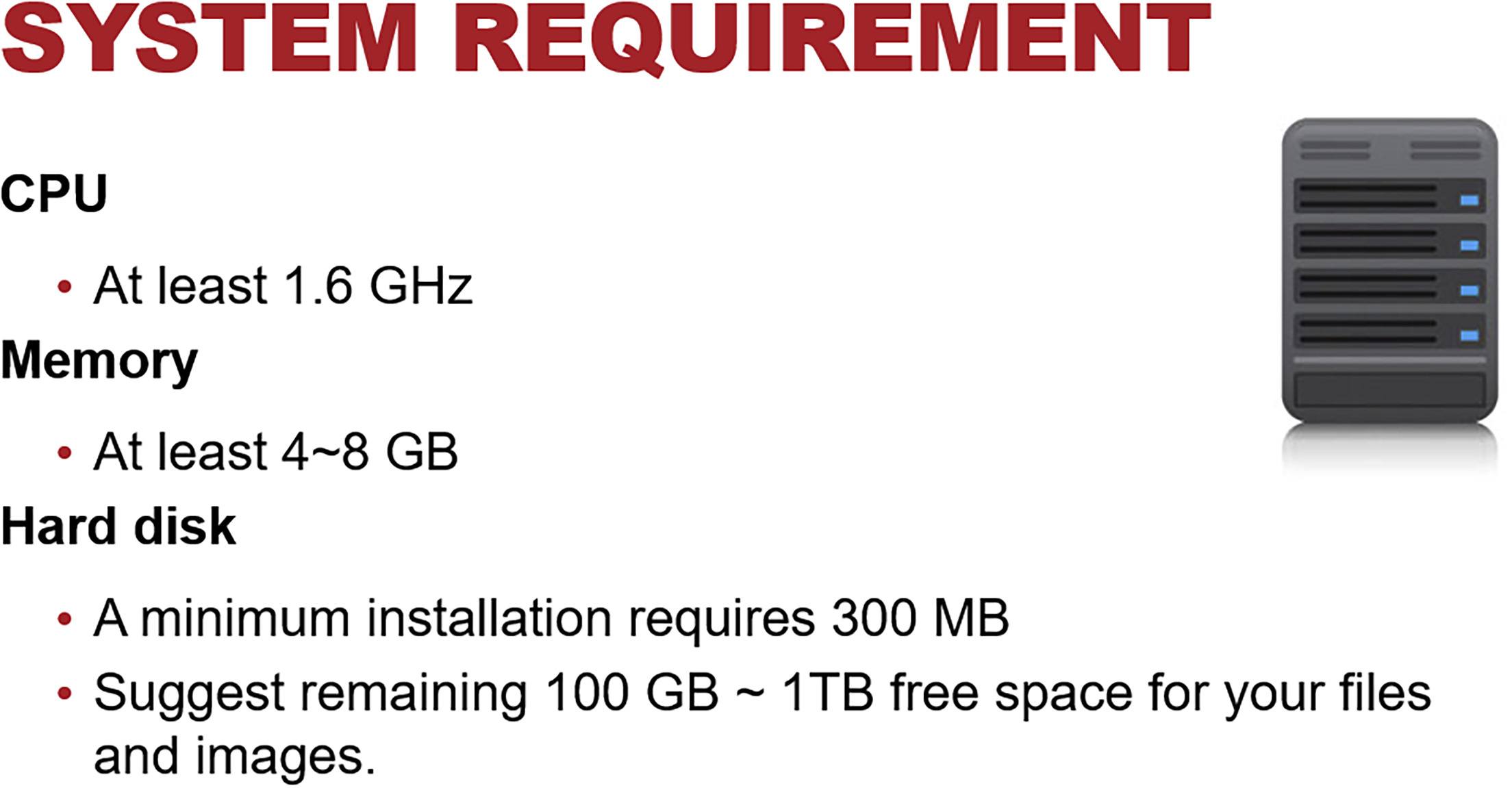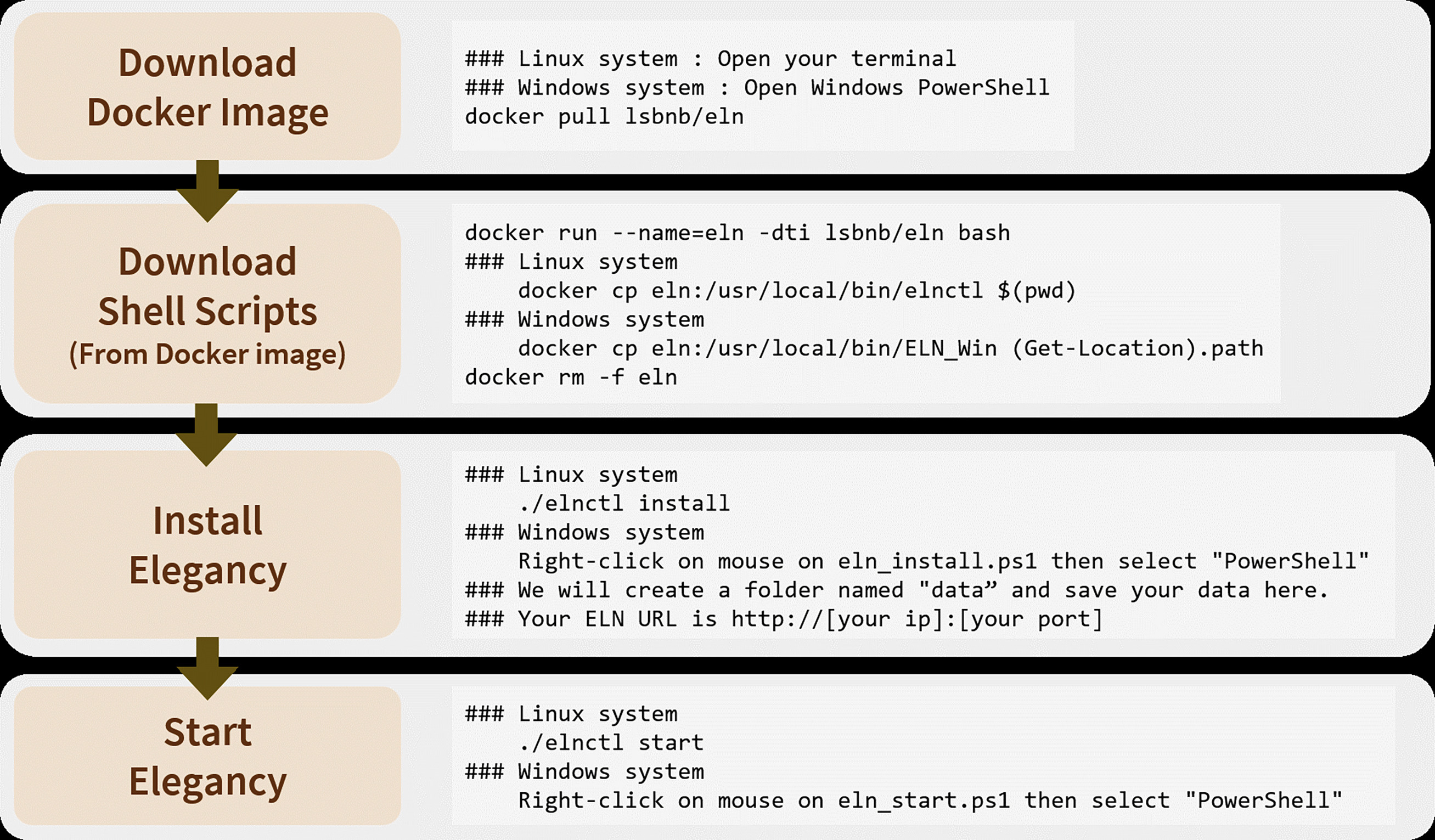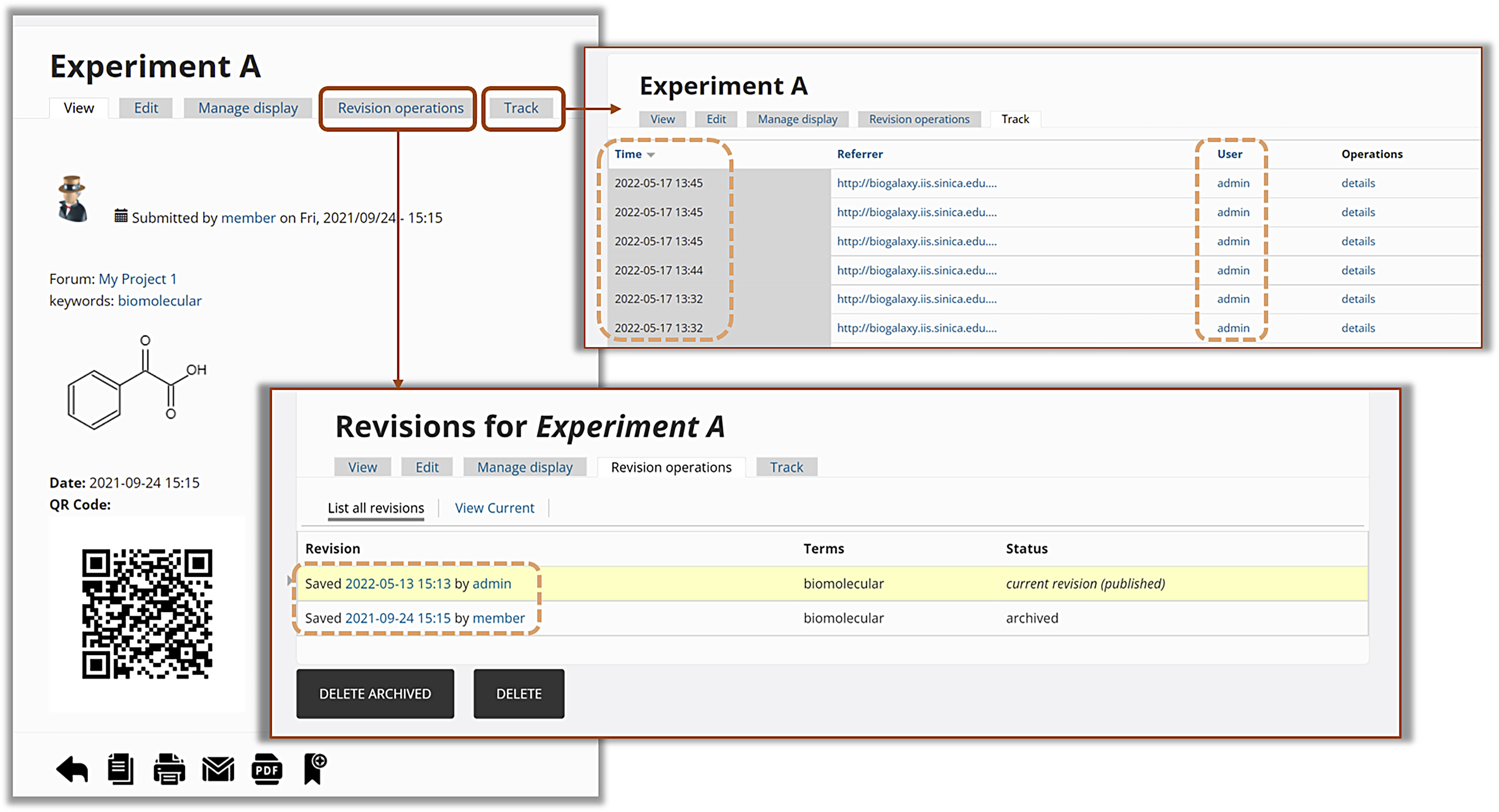Elegancy: Digitizing the wisdom from laboratories to the cloud with free no-code platform
| Full article title | Elegancy: Digitizing the wisdom from laboratories to the cloud with free no-code platform |
|---|---|
| Journal | iScience |
| Author(s) | Huang, Chih-Wei; Chuang, Wei-Hsuan; Lin, Chung-Yen; Chen, Chen, Shu-Hwa |
| Author affiliation(s) | Academia Sinica, Taipei Medical University, National Taiwan University |
| Primary contact | Email: sophia0715 at tmu dot edu dot tw |
| Year published | 2022 |
| Volume and issue | 25(8) |
| Article # | 104710 |
| DOI | 10.1016/j.isci.2022.104710 |
| ISSN | 2589-0042 |
| Distribution license | Creative Commons Attribution-NonCommercial-NoDerivatives 4.0 International |
| Website | https://www.sciencedirect.com/science/article/pii/S2589004222009828 |
| Download | https://www.sciencedirect.com/science/article/pii/S2589004222009828/pdfft (PDF) |
Abstract
One of the top priorities in any laboratory is archiving experimental data in the most secure, efficient, and errorless way. It is especially important to those in chemical and biological research, for it is more likely to damage experiment records. In addition, the transmission of experiment results from paper to electronic devices is time-consuming and redundant. Therefore, we introduce an open-source no-code electronic laboratory notebook (ELN), Elegancy, a cloud-based/standalone web service distributed as a Docker image. Elegancy fits all laboratories but is specially equipped with several features benefitting biochemical laboratories. It can be accessed via various web browsers, allowing researchers to upload photos or audio recordings directly from their mobile devices. Elegancy also contains a meeting arrangement module, audit/revision control, and laboratory supply management system. We believe Elegancy could help the scientific research community gather evidence, share information, reorganize knowledge, and digitize laboratory works with greater ease and security.
Keywords: bioinformatics, computer science, applied computing in physical science, applied computing in medical science, electronic laboratory notebook
Introduction
Paper-based laboratory notebooks have long been the dominant platform for recording experimental data in the scientific community. However, data written on paper cannot easily be searched, shared, or backed up and can easily be misplaced or lost. As stated in one study, up to 17 percent of non-digitized research data are lost yearly.[1] In addition, with the use of increasingly automated and modernized lab equipment, massive volumes of data are generated in a digital rather than physical format. These issues have given rise to electronic laboratory notebooks (ELNs), software platforms capable of storing, organizing, searching, and sharing experimental data.[2] ELNs significantly reduce human error in data archiving, making sharing of data and information more convenient. Users can gain access to an ELN anytime and anywhere. Because ELNs can be saved locally or in the cloud, data are backed up multiple times. Many ELNs are in the market, each with its own merits.[3] For example, SciNote is fairly intuitive and installed locally or through Docker containers.
Similarly, eLabFTW[4] is open-source software that supports local and cloud hosting. eLabFTW also offers a Docker image. However, as with most commercial ELNs, they provide limited storage and only a few functions in their unpaid version.
Thus, we created a cloud-based ELN, Elegancy, which employs a hybrid system of Drupal and our developed modules. Users can install it on local machines or servers with no code at all, and they can access it using a web browser on any mobile device. It is open-source and easy to install and navigate, with all functions available in the same package. Most importantly, Elegancy is entirely free. Elegancy is suitable for laboratories of any type and size. Elegancy would, therefore, be of great use in information sharing and laboratory work management in the research community.
Results
Elegancy is built with a handful of powerful tools that fulfill the basic needs of all kinds of laboratories, as illustrated in Figure 1.
|
Elegancy has several advantages over other ELNs, described below. Elaboration on Elegancy’s complete functions is provided in Supplementary information, Note S1.
Great user experience and practical facilities
Elegancy is easy to set up, with no code required. Users can build their ELN by following the simple instructions and tutorial videos provided on our website. The graphical user interface (GUI) is intuitive and uncluttered. Options are displayed on the top of the panel, including a calendar that also serves as a timestamp. Users can also track the consumption of either office supplies or chemical solvents. English is the default language of Elegancy, with Mandarin and Japanese as built-in options. Users who have the resources for translation may add other languages. We provide multiple background themes for users to choose.
Regarding post-editing, the text editor is similar to commonly used software, such as Microsoft Word or Google Documents. Users can insert code, images, or tables and attach links to uploaded files, multimedia, or other posts (Figure 2).
|
All forum posts can also be exported as PDFs, and their source code is open for template modification if necessary. Elegancy has further been developed to facilitate collaboration. Users can share posts and meeting invitations with other users through e-mail from our ELN. Elegancy also includes a module that analyzes the interactivity between members, which can be presented in charts. Figure 3 is an example of a forum post. Lab members can comment under the main text and reply directly to each comment, thus creating a thread of discussion related to the topic.
|
An all-purpose notebook with special features aimed at biomedical laboratories
Although Elegancy fits all laboratories, it has features that are highly beneficial to experimental labs. We included Math-Type and Chem-Type plugins from CKEditor to create mathematical equations and chemical formulas. A module for drawing chemical structures is provided; users can also import chemical molecule JSON or CML files (Figure 4).
|
What is more, we developed an optimized mobile device interface. Users can upload photos, drawings, or recordings to their ELNs directly from their phones, saving time and reducing human error in moving data from paper to computers (Figure 5). Elegancy also offers a platform for supply and property management. Although only site managers are granted the authority to create new inventories, all lab members can keep track of their property and supply usage by typing in information, e.g., property name, user, keeper, location, and purchased date (Figure 6). There is no limit on the number of inventories, and the entire supply and property record can be exported as CSV files. In short, Elegancy can be used to document both dry- and wet-lab investigations of any research project.
|
|
Fully featured and free to use
Most ELNs on the market offer a variety of service plans, yet the free version usually includes limited functions, storage, and resources. This is not the case with Elegancy. All the necessary functionalities are included in the same package, free of charge. We compared Elegancy with other ELNs based on a recent review of the highest-ranked ELNs[5] and a comparison table between several ELNs[6], as well as the free version of SciNote and eLabFTW (as shown in Table 1). For example, although eLabFTW provides chemical drawing utilities, Elegancy is equipped with those, as well as mathematical and chemical tools. Generally speaking, Elegancy outshines these two ELNs in a handful of aspects. For a detailed comparison between Elegancy and the pricing plans for SciNote and eLabFTW, see Supplemental information, Table S1.
| ||||||||||||||||||||||||||||||||||||||||||||||||||||||||||||||||||||
Optimized Docker image
Elegancy is built based on Drupal (Figure 7), allowing users to add personalized modules. It supports operating systems such as Windows, Mac OS, Linux, and several web browsers, including Google Chrome, Firefox, Safari, Internet Explorer, and Opera. We highly recommend choosing Elegancy’s Docker image over local installation for several reasons. First, cloud backups can spare users the trouble of transferring or restoring databases between hardware storage devices. Second, it enhances data preservation security. Third, users can access their ELN from any device anytime and anywhere.
|
The full online resources of Elegancy are shown in Figure 8. The basic hardware requirements to install Elegancy are shown in Figure 9, and the basic instruction for setting up our Docker image with these control scripts is illustrated in Figure 10.
|
|
|
Data security and user authorization
Several aspects of the platform guarantee data security. First, we set up an SSL certificate upon installation to prevent unauthorized access and encrypt data during transmission. We allow only one web server portal to be opened and close all others to prevent any malicious invasion. We set the maximum number of login attempts to three times to prevent botnet attacks. Once surpassing this limitation, the user would be locked out for five minutes before signing into their ELN again. Secondly, user access is divided into different levels of authority: Guest, Lab Member, Project Leader, and Site Manager (see Supplemental information, Note S1, Section 3.1). Moreover, using the Docker images ensures remote data backup and easy database restoration.
Not all ELNs address version control and time-stamping, but this functionality could greatly enhance data integrity.[7] We complied with the RFC 3161 Time-Stamp Protocol[8] and most of the main requirements regulated by 21 CFR Part 11.[9] The five specific requirements of 21 CFR Part 11 are validation, audit trails, legacy systems, copies of records, and record retention. We cannot fulfill the requirements for legacy systems and parts of audit trials as we do not currently provide an electronic signature service. However, the current version of Elegancy offers a computer-generated, time-stamped audit trail that includes all records, each indicating date, time, and actions such as create, modify, and delete. We believe these functions are sufficient for now as Elegancy is not commercial-oriented, and we do not profit from it. The free version of eLabFTW only complies with RFC 3161, while the free version of SciNote does not have audit trials. Nevertheless, we may include electronic signatures in future releases of Elegancy in the form of an optional function. For example, we are considering introducing a blockchain infrastructure for scientific research by adding Bloxberg as a module of Elegancy, to create a transparent footprint of each scientific record without revealing its content. Such an approach would comply with FDA or healthcare data privacy requirements.
All events and modifications are recorded according to username, date, and time, as illustrated in the prior Figure 7. It marks the current version in the “status” column. Only members assigned to this forum have access to these revision records. By clicking on the “Track” icon in Figure 11, users can also view all records of interaction related to this specific forum post, i.e, which members viewed, edited, commented on, or shared this post. This list of records is available to site managers only by default but could be accessible to all lab members by choice. Finally, as we don’t provide any form of data hosting or pricing service, data stored on the users’ device, cloud or server should also warrant data security and confidentiality.
|
Discussion
In summary, Elegancy offers many functions for all types of research labs, especially biomedical research. It supports both local and cloud hosting, which are available with a Docker image. The installation steps are simple, and the user interface is intuitive. Tutorials of Elegancy’s basic functions and an introduction video of the overall features are provided online. Elegancy is compatible with several operating system layers and can be accessed anywhere through any electronic device. It also includes special features specifically for mobile device use. Most importantly, Elegancy is free to use for all users.
Limitations of the study
Elegancy continues to develop and is expected to receive several feature improvements. First, our team plans to add an auto-reminder function for time-consuming programs or experiments. Second, modern laboratory equipment typically supports exporting results in a digital format. Therefore, we attempt to develop a function via an application programming interface (API) that directly inputs experiment data into the ELN under a folder specially created for this purpose. As it is impossible to conform to every kind of data format, we may start by extracting keywords such as the basic information shared by most formats (time, date, size, etc.) and then continue to customize them in the future. Third, Jupyter Notebook is widely used and indispensable to many laboratories, and as such, binding Jupyter Notebook to our ELN would benefit those highly dependent on it.
Moreover, it is proved feasible to create semantic documentation for research data using ELN protocols from wet-lab experiments.[10] Similarly, our team hopes to be able to not only import protocols from web pages, such as Protocols.io, but sync the database to our ELN to assist in extremely complex experiments with numerous detailed steps. Finally, we plan on including electronic signatures as an optional function for audit trials. Users can enable this feature based on their needs.
Development resources and details
- Drupal 7, via Dries Buytaert
- MySQL 8.0.25, via Oracle Corporation
- Apache HTTP Server 2.4.41, via Apache Software Foundation
- PHP 7.1.33, via The PHP Development Team, Zend Technologies, and PHP Foundation
- CKEditor, via CKSource
- Docker, via Dirk Merkel
- SSL Certificate, via SSL.com
Fundamental structure
The open-source content management platform Elegancy is developed based on Drupal 7. The entire platform of Drupal consists of four layers: nodes, modules, blocks and menus, and user permissions. It regards all content as a node, behind which many modules control its display, modification, arrangement, and classification. More deeply, Drupal also uses blocks and menus. Blocks often provide the output from a module or can be created to display whatever the user wants and then can be placed in various spots in customized template layouts. Menus are a core element of Drupal, providing links to all the pages created in Drupal. Finally, permissions determine what users are allowed to do and see. This design allows Drupal not only to create an ordinary blog site but control the way content is displayed and handle permissions with appropriate components. It can instantly become a forum, wiki, personal website, social network, and shopping site.
A total of 190 operating modules are found in Elegancy, including core components, the management interface, content creation, data sharing, search engine capacity, panel construction, multilingual support, information safeguarding, and backup and restore capabilities. Among those modules, 170 are modified from the built-in modules, and 20 are constructed by our research and development team. MySQL 8.0.25 was used to establish the database, and Apache HTTP Server 2.4.41 was used to set up the webserver. The programming languages implemented here are PHP 7.1.33, HTML, and CSS. CKEditor, a WYSIWYG text editor specially used on web pages and available as open-source, is the main module implemented in Elegancy. It aims to be lightweight and can be used without over-complicated installation steps. There are a handful of plugins that can be used together with CKEditor. All is possible within a single editing framework from editors similar to Google Docs or Twitter-like applications. Users can add text, programming code, chemical formulas, math equations, hyperlinks, handwriting, table, image, audio, video, or other file types. We also added some customized plugins to the default settings, i.e., the three features developed for mobile devices: audio recording, photo uploads, and doodling on screen. These additional customized features are compatible with all versions of CKEditor.
Installation and implementation
To ensure that even users without a background in computer science can easily navigate Elegancy, our team focused on developing an ELN that can be swiftly installed by following simple instructions. Elegancy supports both local and cloud installation. With Inno Setup as the foundation for local installation, we wrapped software packages like Apache, MySQL, and PHP into our installation program. We also included JRE in the package because Java was used in writing programs related to ELN management, which are required for initiating and shutting down ELNs. Local download is currently available for Windows only. However, with the Docker image we provide, the prior-mentioned software is wrapped with the Docker developer, allowing users to install and build their ELNs on different operating systems (e.g., Linux and Windows), DOCKER environments, NAS drives, or cloud computing platforms. To save users from learning complicated Docker commands, we offer a Shell Script with the required commands for installation written inside with no code. For more detailed tutorials, please visit the website housing our user guide.
Data and code availability
The Docker image of Elegancy is freely accessible at both Docker.com and GitHub.com. Upon each download of Elegancy, we collect the basic information of our users, i.e., download time, IP address, user name, affiliation, and e-mail, via a questionnaire survey. The results are shown in the Supplemental information.
We also provide a demo website for potential users, as well as a thorough user guide. A brief introduction video of Elegancy is available on YouTube. Detailed information about deployment, installation, setting, and system management is described in the Supplemental information.
Supplemental information
Acknowledgements
The authors thank the fund 110-2320-B-038 -087 -, 110-2314-B-001-006 - and 110-2311-B-001-020 - by the Ministry of Science and Technology (MOST), Taiwan, and partly sponsored by a grant from Institute of Information Science, Academia Sinica, Taiwan, for financially supporting this research and publication. We also thank Nai-Hsuan Huang, Teng-Chieh Huang, and Shih-Chieh Ilya Li for participating in developing the platform of Elegancy and providing valuable suggestions. Finally, we thank the National Center for High-performance Computing (NCHC), which kindly provided cloud resource for developing the ELN in the cloud.
Author contributions
System development – C.W.H. and C.Y.L.; article writing – W.H.C. and C.W.H.; article review & editing – C.Y.L. and S.H.C.
Resource availability
Further information and requests for resources should be directed to and will be fulfilled by the lead contact, Chung-Yen Lin (cylin at iis dot sinica dot edu dot tw).
Competing interests
The authors declare no competing interests.
References
- ↑ Vines, Timothy H.; Albert, Arianne Y.K.; Andrew, Rose L.; Débarre, Florence; Bock, Dan G.; Franklin, Michelle T.; Gilbert, Kimberly J.; Moore, Jean-Sébastien et al. (1 January 2014). "The Availability of Research Data Declines Rapidly with Article Age" (in en). Current Biology 24 (1): 94–97. doi:10.1016/j.cub.2013.11.014. https://linkinghub.elsevier.com/retrieve/pii/S0960982213014000.
- ↑ Riley, Erin M.; Hattaway, Holly Z.; Felse, P. Arthur (1 December 2017). "Implementation and use of cloud-based electronic lab notebook in a bioprocess engineering teaching laboratory" (in en). Journal of Biological Engineering 11 (1): 40. doi:10.1186/s13036-017-0083-2. ISSN 1754-1611. PMC PMC5701295. PMID 29201138. https://jbioleng.biomedcentral.com/articles/10.1186/s13036-017-0083-2.
- ↑ Huchet, B. (30 March 2021). "2021 Review of the Best Electronic Laboratory Notebooks". Labs Explorer. https://www.labsexplorer.com/c/2021-review-of-the-best-electronic-laboratory-notebooks_222.
- ↑ Hewera, Michael; Hänggi, Daniel; Gerlach, Björn; Kahlert, Ulf Dietrich (2 August 2021). "eLabFTW as an Open Science tool to improve the quality and translation of preclinical research" (in en). F1000Research 10: 292. doi:10.12688/f1000research.52157.3. ISSN 2046-1402. PMC PMC8323070. PMID 34381592. https://f1000research.com/articles/10-292/v3.
- ↑ Kovac, K. (26 May 2021). "Best Electronic Lab Notebook (ELN) Review for Your Lab in 2021". SPLICE. Biosistemika, LLC. https://www.splice-bio.com/best-eln-review-for-your-lab-2021/.
- ↑ Harvard Longwood Medical Area Research Data Management Working Group (19 May 2021). "Electronic Lab Notebook Comparison Matrix" (in en). Zenodo. doi:10.5281/ZENODO.4723753. https://zenodo.org/record/4723753.
- ↑ Higgins, Stuart G.; Nogiwa-Valdez, Akemi A.; Stevens, Molly M. (1 February 2022). "Considerations for implementing electronic laboratory notebooks in an academic research environment" (in en). Nature Protocols 17 (2): 179–189. doi:10.1038/s41596-021-00645-8. ISSN 1754-2189. https://www.nature.com/articles/s41596-021-00645-8.
- ↑ Adams, C.; Cain, P.; Pinkas, D.; Zuccherato, R. (1 August 2001) (in en). Internet X.509 Public Key Infrastructure Time-Stamp Protocol (TSP). pp. RFC3161. doi:10.17487/rfc3161. https://www.rfc-editor.org/info/rfc3161.
- ↑ "Part 11 - Electronic Records; Electronic Signatures". Code of Federal Regulations. National Archives. 2020. https://www.ecfr.gov/current/title-21/chapter-I/subchapter-A/part-11.
- ↑ Schröder, Max; Staehlke, Susanne; Groth, Paul; Nebe, J. Barbara; Spors, Sascha; Krüger, Frank (1 December 2022). "Structure-based knowledge acquisition from electronic lab notebooks for research data provenance documentation" (in en). Journal of Biomedical Semantics 13 (1): 4. doi:10.1186/s13326-021-00257-x. ISSN 2041-1480. PMC PMC8802522. PMID 35101121. https://jbiomedsem.biomedcentral.com/articles/10.1186/s13326-021-00257-x.
Notes
This presentation is faithful to the original, with minor changes to presentation; grammar and spelling required more cleanup for improved readability. In some cases important information was missing from the references, and that information was added. The original article listed references in alphabetical order; this version lists them in order of appearance, by design. The original has images out of place; they were rearranged to make the most sense for this version. Nothing else was changed in accordance with the NoDerivatives portion of the license.















